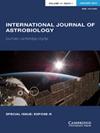空间环境如何影响生物体:天体生物学的观点与评述
IF 1
4区 物理与天体物理
Q3 ASTRONOMY & ASTROPHYSICS
引用次数: 11
摘要
摘要太空独特的环境有几个应力因素,包括强辐射、微重力、高真空和极端温度等。这些应激条件单独或组合影响遗传学和基因调控,并给生物体带来在地球重力状态下不会发生的潜在进化变化(1×g)。因此,可以探索空间来支持新品种微生物和植物的出现,当选择这些微生物和植物时,它们可以表现出增加的生长和产量,提高对病原体的抵抗力,增强对干旱、低营养和疾病的耐受性,产生新的代谢产物等。在1×g以下使用其他方法可能更难实现这些特性。这篇综述概述了对生物体产生重大影响的空间微重力和电离辐射条件。说明了真实和模拟微重力和辐射条件下生物体基因组学、生理学、表型、生长和代谢产物的变化。空间生物学实验结果表明,空间环境具有巨大的科学、技术和商业潜力。结合这些潜力可以帮助解决地球上生命的未来问题,这是天体生物学目标e的一部分。本文章由计算机程序翻译,如有差异,请以英文原文为准。
How the space environment influences organisms: an astrobiological perspective and review
Abstract The unique environment of space is characterized by several stress factors, including intense radiation, microgravity, high vacuum and extreme temperatures, among others. These stress conditions individually or in-combination influence genetics and gene regulation and bring potential evolutionary changes in organisms that would not occur under the Earth's gravity regime (1 × g). Thus, space can be explored to support the emergence of new varieties of microbes and plants, that when selected for, can exhibit increased growth and yield, improved resistance to pathogens, enhanced tolerance to drought, low nutrient and disease, produce new metabolites and others. These properties may be more difficult to achieve using other approaches under 1 × g. This review provides an overview of the space microgravity and ionizing radiation conditions that significantly influence organisms. Changes in the genomics, physiology, phenotype, growth and metabolites of organisms in real and simulated microgravity and radiation conditions are illustrated. Results of space biological experiments show that the space environment has significant scientific, technological and commercial potential. Combined these potentials can help address the future of life on Earth, part of goal e of astrobiology.
求助全文
通过发布文献求助,成功后即可免费获取论文全文。
去求助
来源期刊

International Journal of Astrobiology
地学天文-地球科学综合
CiteScore
3.70
自引率
11.80%
发文量
45
审稿时长
>12 weeks
期刊介绍:
International Journal of Astrobiology is the peer-reviewed forum for practitioners in this exciting interdisciplinary field. Coverage includes cosmic prebiotic chemistry, planetary evolution, the search for planetary systems and habitable zones, extremophile biology and experimental simulation of extraterrestrial environments, Mars as an abode of life, life detection in our solar system and beyond, the search for extraterrestrial intelligence, the history of the science of astrobiology, as well as societal and educational aspects of astrobiology. Occasionally an issue of the journal is devoted to the keynote plenary research papers from an international meeting. A notable feature of the journal is the global distribution of its authors.
 求助内容:
求助内容: 应助结果提醒方式:
应助结果提醒方式:


